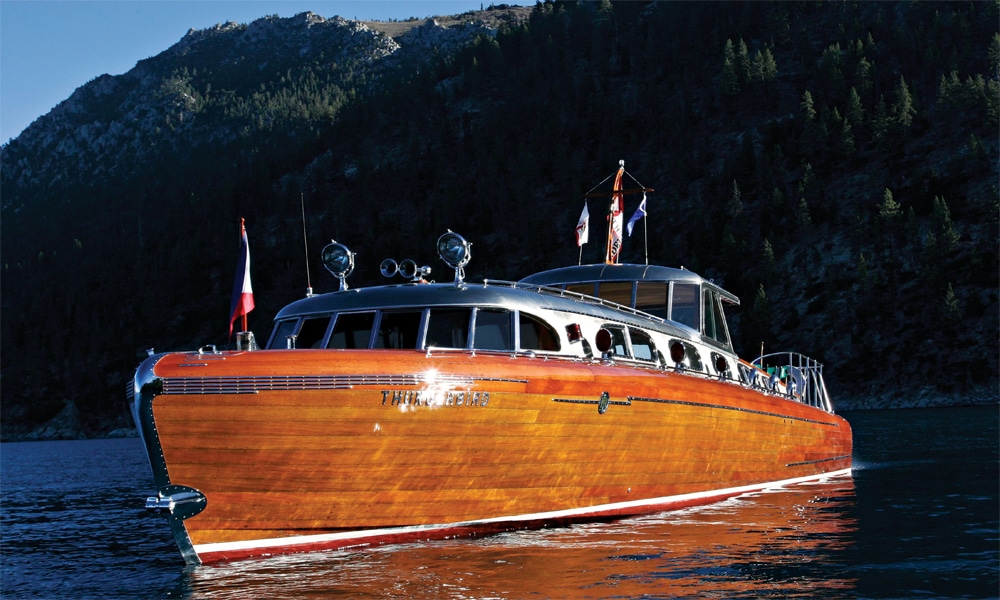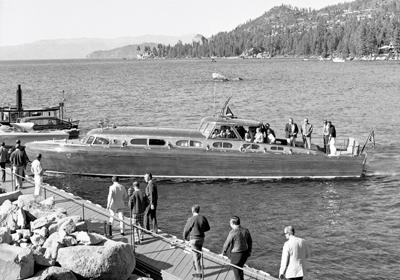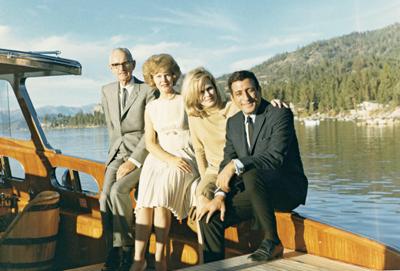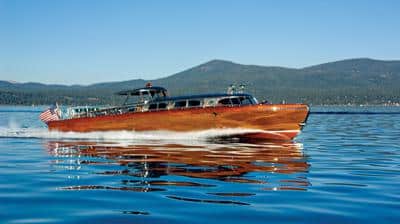
Thunderbird
I have always considered myself an ocean person — you know, choosing from the possibilities of ocean, desert, mountain or plain — though I wondered why anyone would want to choose as I drove down the mountainside toward Thunderbird Lodge and got my first glimpse of Lake Tahoe. The soaring peaks were capped in white; the evergreen-covered slopes were dusted with snow; even the windshield wipers of my rented Ford Focus swung furiously as they battled an early November snow squall — and in the middle of it all was Lake Tahoe — vast and empty, buffeted by white-capped chop.
From a distance, it’s easy to see how much of this beautiful region has remained undeveloped and wild. One man who helped make it so was George Whittell Jr., who purchased about 100,000 acres and 27 miles of shoreline on the Nevada side of the lake. The son of a family with gold-rush money on both sides, Whittell was born into a life of wealth and privilege. From an early age, though, he went his own way — and with gusto. He joined the circus and became a lion tamer. He married two chorus girls in succession before wife number three, a well-bred French woman named Elia who looked the other way as Whittell carried on with his playboy lifestyle.
“Whittell was always said to love the four Gs,” said Bill Watson, manager and curator of Thunderbird and Thunderbird Lodge, as he led me through the 600-foot underground tunnel connecting Whittell’s beautiful lakeside estate to the boathouse. “Girls. Gambling. Giraffes. And Gadgets.”
After a brief pause off the tunnel in a side room with a fireplace, known as “the opium den,” we emerged in the massive boathouse. And there she was, the legendary Thunderbird, stern to the door, her twin supercharged Allison V-12 aircraft engines removed for servicing. In the soft sunlight that filtered through the high windows of the Thunderbird Lodge boathouse, the engines gleamed with an almost sculptural beauty. Capable of putting out 3,000 horsepower, they are detuned to generate about 1,100 horsepower apiece.
I walked across an aluminum gangplank and through the stripped-down boat, picking my way across areas of open sole and plastic-dropcloth-covered seating. It wasn’t Thunderbird’s most glamorous moment, but like all great beauties, she didn’t need primping to dazzle.
First mate Mark Taylor was crouched low in the stern and pointed to his next project: sandwiching the stringers with aluminum to better support the engine mounts. It’s a far cry from his summertime gig aboard Thunderbird. “Coming into the boathouse is like flying a boat,” he grinned. “Thunderbird idles at nine knots — she just doesn’t know how to go slow.”
John L. Hacker designed Thunderbird for Whittell, who requested a yacht that reflected his love of Duesenberg autos (which he collected) and DC-2 aircraft (which he also owned). Fashioned of double-planked mahogany and brushed stainless steel, Thunderbird was originally powered by twin 550-horsepower Kermath aircraft engines that pushed the boat to 60 knots.

Built by Huskins Boat Works in Bay City, Michigan, and delivered to Whittell in the summer of 1940, Thunderbird enjoyed only two seasons of Whittell’s active use before he became increasingly reclusive, restricting his movement to the tunnels around Thunderbird Lodge and spending most of his time with Bill, his pet lion. Over the next few decades, sightings of Thunderbird were so rare that they took on the air of fable.
When casino magnate Bill Harrah acquired Thunderbird in 1962, the Kermath engines had only 83 hours of use. Harrah removed them, converting the stern area to open the cockpit for carrying headlining passengers like Tony Bennett, Sammy Davis Jr. and Frank Sinatra. Harrah had twin Allisons positioned below the cockpit sole and added the stainless steel flying bridge that Thunderbird sports today. Though she is undeniably still stunning, the original lines had a streamlined, almost rocketlike quality that’s been lost to these more user-friendly improvements.

Thunderbird is now owned by Foundation 36, which is dedicated to preserving Nevada’s natural, cultural and historic treasures. Watson describes Foundation 36’s acquisition of Thunderbird as a many-pronged process that bordered on spookily preordained, culminating in Thunderbird’s previous owner, Joan Gibb, agreeing to take a much less lucrative offer to prevent the yacht from moving out of state. The original loan that secured Thunderbird for the foundation will be paid off by generous donors if a matching endowment to preserve her can be met (see “The Clock Is Ticking” below).
“We are blessed that Thunderbird is in the public trust,” points out Watson. Today, she spends much of her time educating local children in a maritime heritage program, and anyone can come to Thunderbird Lodge to see the boat. “We will lose her,” Watson sighs, “if we can’t meet this endowment.” There are constant offers (many from abroad) to buy her. Efforts are underway to put her on the National Register of Historic Places, but Thunderbird doesn’t need a plaque. She is a piece of living history and a uniquely American national treasure — a beautiful vestige of one eccentric man’s dreams, which live on in the stunning mountains and the deep, blue lake he chose as home.

The Clock is Clocking
Help save Thunderbird.
Foundation 36 is actively seeking corporate sponsorships or contributions toward Thunderbird’s running expenses. Donations of airplane fuel, for instance, or replacement parts for her rare Allison engines, would be enormously helpful. If you or your company can help Thunderbird, please call or write:
Bill Watson
Manager and Curator
Thunderbird Yacht
watson@thunderbirdlodge.org
316 California Ave., No. 36
Reno, NV 89509
Tel: 775-832-8755
Fax: 775-201-1454
Individual donations to help preserve the Thunderbird yacht are also gratefully received. They can be made payable to Thunderbird Yacht and mailed to:
Thunderbird Yacht
c/o Foundation 36
316 California Ave., No. 36
Reno, NV 89509
Parties may also charter Thunderbird in exchange for generous charitable contributions. Foundation 36 and Thunderbird yacht are 501(c)(3) public charities. Contributions may be tax-deductible to the extent permitted by law.
Read another Classic Boat Special about the 1949 Bolero.









